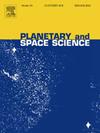模拟热液冲击系统中腺嘌呤与皂土相互作用的稳定性及其对天体生物学的意义
IF 1.7
4区 物理与天体物理
Q3 ASTRONOMY & ASTROPHYSICS
引用次数: 0
摘要
对于与有机分子的化学演化有关的天体生物学研究,必须建立一个合理的地质背景,要么是在早期地球上,要么是在太阳系内另一个可行的地点。撞击产生的热液系统可能为生命起源之前的生命前化学反应提供了理想的环境。在这项研究中,我们使用皂土模拟了这种系统的条件,皂土是一种粘土矿物,被认为是撞击坑中热液蚀变的产物,曾经有热液活动。选择腺嘌呤作为模型有机分子是因为它的生物学相关性和已知的非生物形成,在某些陨石中检测到它。通过对吸附动力学和等温线的分析,研究了皂土与腺嘌呤的相互作用,发现在酸性pH(3.5)下,大约97%的腺嘌呤被吸附,有利于吸附。通过XRD、FRX、Raman、ATR-FTIR、uv -可见分光光度法、HPLC-UV色谱等光谱技术观察分子与粘土的相互作用。此外,还对腺嘌呤水溶液和腺嘌呤皂土混合物进行了热裂解实验。结果表明,皂土具有一定的保护作用,在100 ~ 200℃的温度范围内,在3.5 ~ 8.9的pH范围内,可防止腺嘌呤的分解。这些过程对天体生物学至关重要,因为它们证明了一些粘土矿物如何在早期的地球、火星或星子上集中并保存了益生元有机分子,从而促进了生命的出现。本文章由计算机程序翻译,如有差异,请以英文原文为准。
Stability of adenine in interaction with saponite in a simulated hydrothermal impact-generated system and its implications for astrobiology
For astrobiological studies related to the chemical evolution of organic molecules, it is essential to establish a plausible geological context, either on early Earth or at another viable site within the solar system. Impact-generated hydrothermal systems may have provided an ideal environment for prebiotic chemical reactions before the origin of life.
In this study, we simulated the conditions of such systems using saponite, a clay mineral identified as a product of hydrothermal alteration in impact craters that once hosted hydrothermal activity. Adenine was chosen as the model organic molecule due to its biological relevance and its known abiotic formation, as evidenced by its detection in certain meteorites. The interaction between saponite and adenine was investigated by analyzing adsorption kinetics and isotherms, revealing that adsorption is favored at acidic pH (3.5), as under these conditions, approximately 97 % of the adenine is adsorbed. The interaction between the molecule and the clay was observed through spectroscopic techniques such as XRD, FRX, Raman and ATR-FTIR, UV–vis spectrophotometry, and HPLC-UV chromatographic. Additionally, thermolysis experiments were conducted on aqueous adenine solutions and adenine-saponite mixtures. The results indicate that saponite plays a protective role, preventing adenine decomposition at temperatures ranging from 100 °C to 200 °C across a pH range of 3.5–8.9. These processes are critical for astrobiology, as they demonstrate how some clay minerals could have concentrated and preserved prebiotic organic molecules on early Earth, Mars, or planetesimals, facilitating the emergence of life.
求助全文
通过发布文献求助,成功后即可免费获取论文全文。
去求助
来源期刊

Planetary and Space Science
地学天文-天文与天体物理
CiteScore
5.40
自引率
4.20%
发文量
126
审稿时长
15 weeks
期刊介绍:
Planetary and Space Science publishes original articles as well as short communications (letters). Ground-based and space-borne instrumentation and laboratory simulation of solar system processes are included. The following fields of planetary and solar system research are covered:
• Celestial mechanics, including dynamical evolution of the solar system, gravitational captures and resonances, relativistic effects, tracking and dynamics
• Cosmochemistry and origin, including all aspects of the formation and initial physical and chemical evolution of the solar system
• Terrestrial planets and satellites, including the physics of the interiors, geology and morphology of the surfaces, tectonics, mineralogy and dating
• Outer planets and satellites, including formation and evolution, remote sensing at all wavelengths and in situ measurements
• Planetary atmospheres, including formation and evolution, circulation and meteorology, boundary layers, remote sensing and laboratory simulation
• Planetary magnetospheres and ionospheres, including origin of magnetic fields, magnetospheric plasma and radiation belts, and their interaction with the sun, the solar wind and satellites
• Small bodies, dust and rings, including asteroids, comets and zodiacal light and their interaction with the solar radiation and the solar wind
• Exobiology, including origin of life, detection of planetary ecosystems and pre-biological phenomena in the solar system and laboratory simulations
• Extrasolar systems, including the detection and/or the detectability of exoplanets and planetary systems, their formation and evolution, the physical and chemical properties of the exoplanets
• History of planetary and space research
 求助内容:
求助内容: 应助结果提醒方式:
应助结果提醒方式:


